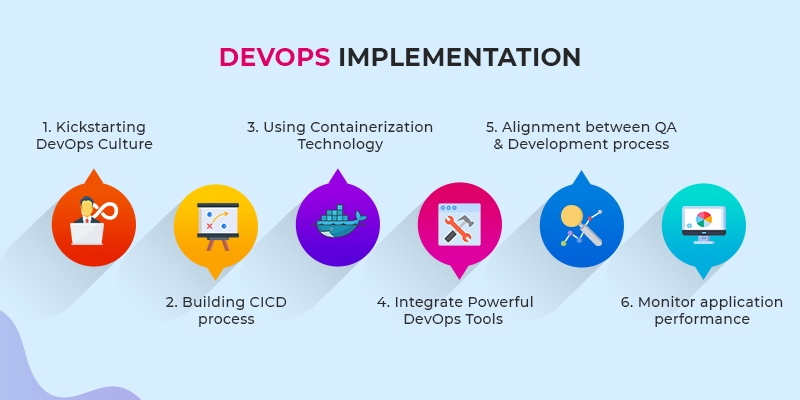DevOps has slowly become the buzzword in the industry. There is a lot of information and strategies for DevOps. But a concrete plan for DevOps implementation is still lacking. In this blog, we have discussed how to implement DevOps in an organization.
There are various advantages in adopting DevOps
DevOps breaks down IT silos and align the IT objectives with the business objectives. It allows nullifying the gaps in software development and delivery, helping induce competitiveness in the business process. It also allows complete visibility across teams.

Our DevOps implementation has been discussed below
(a) Build the case for introducing DevOps
The CIO needs to identify the case for the introduction of DevOps in the organization. The use cases may be the faster reach of company solutions and services to the market, debugging the IT processes in the organization, faster delivery of applications and more.
(b) Introducing the DevOps initiative
The CIO needs to introduce the DevOps initiative and the investment, planning, infrastructural requirements, the change management needs to be set up for fortifying the DevOps initiative into a concrete plan for transition to DevOps.
(c) Changes in Development and Operations teams planned
The changes may include one or all of the following
- Pre- DevOps ————————————> DevOps (Changes)
- Strict segregation of tasks among teams———–> Integrated teams for doing tasks
- Non-communication between teams———> Establishing communication channels between teams
- Unit Testing ——————————–> Integrated software testing pre and post-release
- The delivery team not accountable for software fixes———-> Delivery team accountable for fixes
- The traditional hierarchy of management————–> Flexible and new hierarchy of management
- Traditional tools used in IT process——————> A different toolset or toolchain to address the stages from coding, build, integrated testing, release, delivery and others
- Teams restricted to perform a single function——–> Team having cross-team functional capabilities and skills with the aid of tools.
(c) Developing the DevOps strategy
The DevOps strategy is framed to establish communication lines between the DevOps team, train them on different aspects of DevOps in the organization, equip them with a toolset for cross-team performance, develop new ways of infrastructure provisioning, software development and testing, design the infrastructure as a code process, testing automation, integration and deployment, releases etc.
The DevOps strategy encompasses change in the entire mindset of the IT personnel in the organization. It includes defining the ownership and responsibilities of the DevOps team, designing the escalation protocols, identifying and setting the metrics to know where the organization stands and what the DevOps team need to achieve. Multiple other elements need to be properly defined for DevOps strategy formation.
Ready to automate dev & ops to shorten the SDLC?
Talk to our experts today & see how they can help to fulfill your business objectives.
(d) Containerization
Containers have everything to runs applications like configuration files, libraries and dependencies. Implementing containerization enables stable running of the containerized parts of the application irrespective of the environment and independent of the overall IT infrastructure. This enables inducing changes without the need to rebuild the entire software application, thereby helping the operation team when they need to induct certain changes required for some specific microservice.
( e) Integrating infrastructure automation with CI/CD tools
Integrating infrastructure automation tools with CI/CD tools enable effective configuration management and deployment. Example: Integrating Kubernetes, Ansible, Chef or Puppet with bamboo, Jenkins or Go CD.
(f) Enabling alignment of QA and Development Team
This alignment helps in ensuring software quality pre and post-release and debug and fix the errors before the next build.
(g) Continuous Performance Monitoring of Applications
Continuous application performance monitoring with tools like Nagios, Zabbix and Prometheus help in resolving runtime errors, long time to troubleshoot incidents, poor configuration, memory leaks and so on.
Well, this is the outline of DevOps implementation in an organization. If you are planning for DevOps implementation and does have the right team, right tools and the right experience to expedite that, you can of course connect with us at iSmile Technologies









